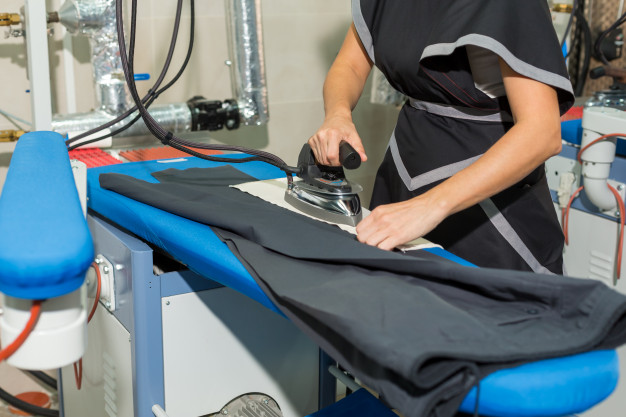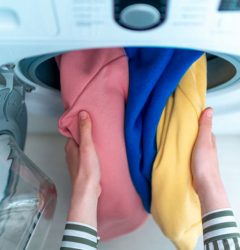
Dry cleaning or washing? Which one is the best?
Although the number of people who use professional companies to clean their dirty laundry has increased, lots of us don’t know the differences between dry cleaning and washing (laundry cleaning).
In this article, on London Dry Cleaning Company, you will know the difference between the two, and you will also learn which one suits your needs.
Let’s start with definition of dry cleaning and laundry washing.

What is Dry Cleaning?
It is important to know what happens to your clothes during a dry cleaning process. Dry cleaning is any cleaning process for clothing and textiles using a solvent other than water. The modern dry cleaning process was developed and patented by Thomas L. Jennings.
The most common solvent employed is Perchloroethylene (also known as Tetrachloroethylene), or “Perc” for short.
Despite the name, dry cleaning is a process that uses liquid other than water. In this process, clothes, bedding, and all different types of fabrics can be cleaned.
It seems that water never damages fabrics. You should know it can damage certain fabrics such as wool, leather, and silk.
During the cleaning process, a single machine wets the clothing with the solvent, tumbles the clothes around in the same manner as a front-loading washing machine, then drys the clothes by removing the solvent from the clothes and capturing it and recycling it for further use and eventually disposal.
Unlike the phrase employed to describe the process, clothing does not stay dry during the dry cleaning process. It just doesn’t get wet with water.
Dry Cleaning can be beneficial for garments made from fibers that don’t react well when exposed to water, like silk and wool. It’s also good for garments that shouldn’t be exposed to the heat of a traditional dryer.

What is the dry cleaning process?
-
Inspection and Tagging Process:
This is one of the parts that you’re likely most familiar with. You take your garment into the cleaner’s, and the dry cleaner creates a tag for your item. This is also when your clothes are examined for any stains, missing buttons, tears etc.
-
Pre-spotting:
Here is where things begin to get a little hazier for the average dry cleaning customer. Once we’ve dropped off our garments, cleaners will typically go through a pre-spotting process where they’ll apply a chemical solvent, vacuum, or heat to stains on your garment, which helps to remove the stain during the actual dry cleaning process.
-
The Dry Cleaning Process:
This is the part we never see. Once your clothes have been pre-spotted, your clothes are placed into a machine and submerged into a non-water based solvent. The clothes are then rotated in a perforated cylinder where the cleaning solvent is released in a steady amount throughout the entire process. From there, the machine rapidly spins the clothes to get rid of any excess solvent and releases warm air. Your clothes emerge completely dry.
-
Post-spotting:
Here your cleaner will inspect your clothes for any remaining stains and residue and remove them using the same process they did in the pre-spotting stage.
-
Finishing:
Once your clothes have gone through the complete dry cleaning process, they are pressed, steamed, or ironed for presentation. This is the part we love, because it makes our clothes look and feel amazing.
What is laundry cleaning?
Laundry refers to the washing of clothing and other textiles. With laundered items, water and detergent are used.

What is laundry cleaning process?
A complete wet process is a process of cleaning clothes with water, detergents, and other laundry agents like bleaching agents. Your clothing goes through the following method on arrival to your cleaner:
-
Mending:
It’s better to mend the garment if needed, it’s done immediately after inspection.
-
Stains
: sometimes stains need special treatment, so its time is before going to the washing machine.
-
Sorting:
You should sort the garments according to their color or the materials
-
Washing:
Here, your clothing is put in a washing machine using a recommended amount of detergent and then tumbled with water.
-
Drying:
Water will be removed in this process by spinning mode.
There are times when some stains aren’t removed effectively. The process of post-spotting is where these stains may be noticed and the necessary action taken.
-
Finishing:
This step includes getting your cloth or garment ready for wear by pressing or ironing.
-
Packaging
Basic differences between dry cleaning and washing (or laundry cleaning)
-
Solvent
The solvent used is the significant essential difference between these two methods of cleaning.
-
The process
As we explained before, the process of cleaning clothes is different from each other.
-
Cost
The costs of dry brushing are usually a little bit higher than laundry. One of the reason is that dry cleaning is considered to be a more effective method of cleaning, as compared to laundry cleaning. It also involves using expensive chemical solvents.
-
The end-result
Dry cleaning reduces shrinkage and distortion of the fabric. Also with minimizing discoloration and reducing bleeding, dry cleaning can maintain the originality of the materials and protect texture.
On the other hand, some people with sensitive skin may have negative reactions to the chemicals used for dry cleaning process and prefer to do the laundry.

We try to show you the differences between dry cleaning and washing to help you choose the best one with new information.
The London Dry Cleaning Company is here if you need any help. So order and enjoy the service.








